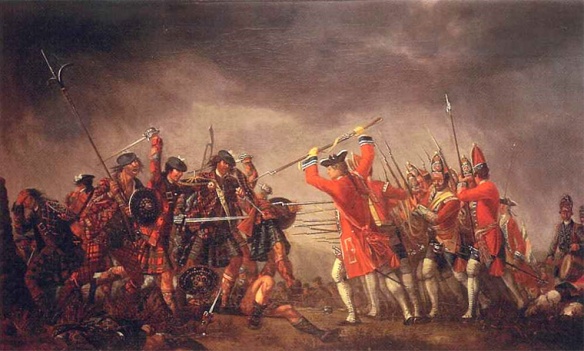
The Highland attack on the Grenadier Company of Barrell’s King’s Own Royal Regiment” by David Morier; painted in 1746 for the Duke of Cumberland.
The final Jacobite campaign, “The ’45,” was first sponsored as a French diversion meant to draw British troops out of the War of the Austrian Succession. A 1744 invasion, to be led by the Marshal de Saxe, fell through after a great storm not only destroyed stockpiled supplies but disrupted the French fleet sent to gain control of the English Channel. Not to be dissuaded, the Stuart claimant, Charles Edward Stuart (“the Young Pretender” or “Bonnie Prince Charlie”), prepared an invasion on his own, borrowing money and counting on a mass uprising upon his arrival in Scotland. Again due to poor weather, the Jacobites arrived with only half the planned men and supplies. (Many began to mutter that “God is a Protestant!”) The Jacobites did muster a number of highlanders, captured Edinburgh Castle, and defeated the local government forces at Prestonpans, before marching south into England with an army of about 4,500. The Jacobite army turned back at Derby, now convinced that there was no support in England or substantial French aid on the way, abandoning a strike at London in favor of a retreat back to Scotland.
Pursued by two Hanoverian armies under the Duke of Cumberland and George Wade, they collected a trickle of smuggled French supplies and, after successfully holding off the government troops at Falkirk, went to ground over the winter of 1745/6.Charles Edward Stuart, emerging from a fit of petulance over the retreat from Derby, insisted on a conventional action rather than continued evasion and in April 1746 met Cumberland at Culloden, where the Jacobites were decisively defeated.
The last land battle fought on British soil. Having retreated into Scotland after a war council at Derby determined that an attack on London, without French aid or local support, would be disastrous, the Jacobite armies of Charles Edward Stuart wintered close to the ground and steadily moved to the northwest of Scotland. The prince himself, disappointed by the failure of the march on London, pressed for a direct engagement with the Hanoverian forces, which had followed from Derby under the command of the Duke of Cumberland and General George Wade. Many of the prince’s advisers, however, counseled a sustained guerrilla campaign, hoping to gain something out of a negotiated peace. Ultimately, the prince insisted on meeting the Hanoverian army at Culloden, east of Inverness, on a field with several significant obstacles, including marshy ground. When the battle began around 1 P.M. the afternoon of 16 October, the Jacobite army of about 5,000 immediately found their line thrown into disarray because of the obstacles, with second-line units being brought up to fill the gaps. Both sides fired about 15 minutes of artillery, an action that greatly demoralized the Jacobites, whose own artillery did little damage. When the Jacobite attack came, it was as a Highland charge, advancing at a run, into the Hanoverian lines, with many of the Jacobites drawing swords. The Hanoverians, numbering about 9,000, countered the charge by changing over from ball to canister shot, which devastated the charge, killing a disproportionate number of officers leading “from the front.” The Jacobites were thrown into disarray as the survivors made contact with the front ranks of the enemy, who fired once, then used their bayonets.
While the Jacobites struggled to advance across boggy ground in the face of continuing fire, their right wings began to collapse and run, followed by many units from the left. At this moment, Cumberland sent the two troops of Cobham’s 10th Dragoons in pursuit, followed by a general charge of the Hanoverian army, which turned the retreat into a rout. In a battle that lasted perhaps 40 minutes, the Jacobites had lost nearly 1,000 dead while the government lost only 50. Although the Jacobites claimed that their wounded were systematically butchered on the field, giving Cumberland his nickname “The Butcher,” most survivors died in custody. The ruthlessness with which the government proceeded to end the rebellion, including the prohibitions of Highland traditions such as the bagpipes and plaid, as well as systematic road building and fortification, ended the Jacobite cause in all but romantic memory.
References and further reading: Black, Jeremy. Culloden and the ’45. New York: St.Martin’s Press, 1990. Prebble, John. Culloden. London: Secker & Warburg, 1966. Reid, John. 1745: A Military History of the Last Jacobite Rising. New York: Sarpedon, 1996.